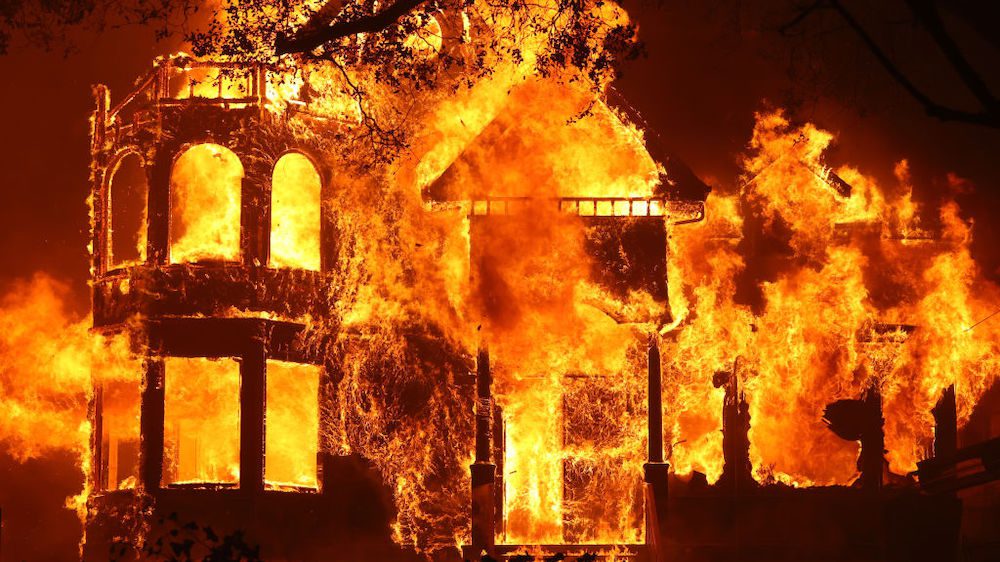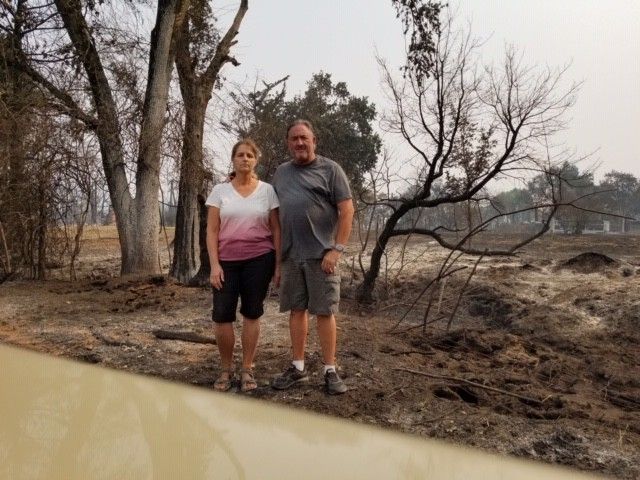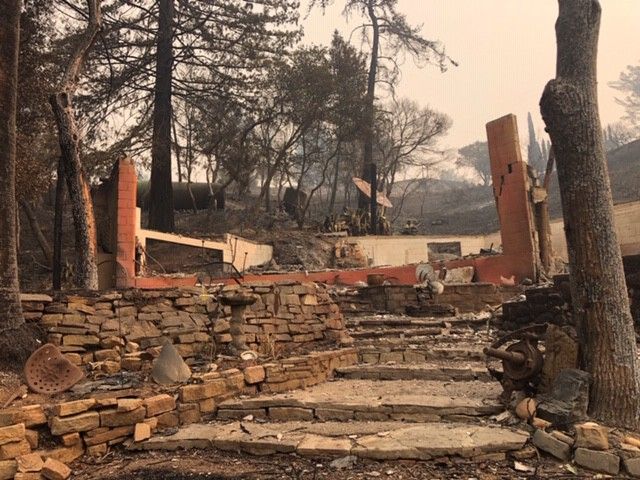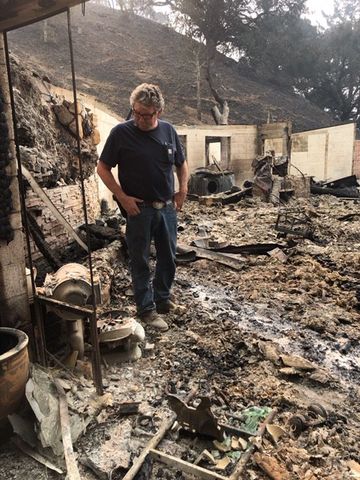
Justin Sullivan/Getty Images
As the devastating Glass fire raged through California’s scenic wine country in late September, Thomas Senander, 63, initially ignored the evacuation orders, But then a few days later, he and his family watched 100-foot flames rush straight in the direction of their Santa Rosa, CA, compound. When the fire began to lick the edges of a field leading onto their property, the retired engineer, his wife, and their grown son sprang into action.
Like many of their neighbors, they’d been through this hell before. Just three years ago Senander and his family lost their previous home—about 6 miles away in the same town—to the Tubbs fire. They were determined not to experience that anguish again.
He connected a fire hose to his 3,500-gallon water tank and blasted the blaze as it barreled toward him. His family poured buckets on runaway flares. The inferno was heading for an old barn on their 2.5 acres. If it sparked, he knew their painstakingly renovated three-bedroom house would be lost, like the charred rubble of what used to be their neighbor’s home across the street.
“The fire was at my feet. I couldn’t see anything because of the smoke,” says Senander. “We were terrified. Some of the [neighbor’s] propane tanks were exploding. Some of them were so powerful that it felt like someone was hitting you in the chest.”
Deadly wildfires have always been a fact of life for Californians. But over the past few years they’ve caused unprecedented devastation—with this year becoming the worst wildfire season on record. In some spots, these blazes are burning awfully close to the same areas that were incinerated just a few years ago, causing a continuing cycle of despair for those who live there. The fires are having a catastrophic impact on lives and businesses across the state.
And they’re having an unexpectedly tumultuous impact on the volatile California housing market: The disasters are helping to push up prices in communities that have been ravaged by the infernos, in some cases dramatically.
It all comes down to an inescapable fact: Those who lost their homes still need places to live. Areas like Napa and Sonoma Counties were already experiencing housing shortages, exacerbated by fires from previous years and pandemic buyers. Deep-pocketed San Franciscans fleeing the city have been buying up spacious homes on large plots of land in the countryside near bucolic vineyards and award-winning restaurants. Now those rendered homeless are competing with transplanted city buyers, driving prices up even further.
However those same fires causing prices to rise could eventually cause demand to falter—especially if they threaten the same areas year after year. That could lead prices to fall down the road. Residents scarred by annual evacuations, close calls, and loss of their homes along with skyrocketing insurance rates may eventually decide to leave the area, and potential new buyers may stay away.
“We have no historical precedent for what we’re seeing in 2020: more fires more widely distributed with more intensity,” says Tom Jeffrey, a senior hazard scientist at CoreLogic, a real estate information firm.
They’ve claimed the lives of 31 people and torn through more than 4 million acres as of Tuesday afternoon, according to the California Department of Forestry and Fire Protection. (Those numbers don’t include the destruction in Oregon and Washington states, where at least 36 lives have been lost this year.) Almost 8,700 structures have been damaged or destroyed, many of those homes. One current fire, the August Complex, which stretches between San Francisco and the border of Oregon, has scorched more than 1 million acres, turning it into a “gigafire”—a new record.
There were five active fires in the state as of Tuesday afternoon. The Glass fire is burning through Napa and Sonoma Counties, the heart of the state’s wine country, where Senander is located.
More than 12,100 homes in the state collectively worth nearly $9.4 billion are at risk, according to a Tuesday analysis of homes in harm’s way by realtor.com®.
“The impact of the fires is rocking the community. … It’s nerve-wracking, it’s scary, it’s disheartening,” says real estate broker Kristofer Chun, of eXp Realty in the town of Napa. “[But] if anything, history has shown when people lose their houses and they want to stay, it increases the demand significantly.”
After overpaying for their last home and battling with their insurance company over their losses, the Senanders were determined not to lose the home they’d moved into only two years earlier. They battled the flames into Monday morning, succeeding at keeping them at bay.
Senander had bought the property specifically because he believed it could withstand another blaze. He set it up with a water tank and pump designed to fight fires. But he doesn’t know what he would do if another blaze erupted.
“I’m just glad we made it through this one” says Senader.

Provided by Thomas Senander
Why prices are soaring in wildfire-ravaged communities—for now
Those who lose their homes in wine country and decide to stay and purchase new homes will be entering a cutthroat real estate market.
The median home list price in Napa County set a new record of $1,299,550 in September—a 30.1% increase from last year. In Sonoma County, the median price was $809,550, representing a nearly 7.7% rise. That’s despite the LNU Lightning Complex fire erupting in mid-August and burning through more than 363,000 acres in Napa, Sonoma, Yolo, Lake, and Solano Counties.
Sales in Napa County were up 40% in the third quarter of this year compared with the same quarter last year, according to real estate brokerage Compass. They rose 53.1% in Sonoma County.
We’re “experiencing very high growth and high buyer demand,” says real estate broker Chun. However, “we’re already short of housing. Most properties are getting multiple bids. People who lost their house need to have someplace to live.”
After a large-scale disaster, it’s typical to see widespread price gouging in surrounding communities that were spared, says appraiser Randall Bell, CEO of Landmark Research Group, which analyzes real estate after cataclysmic events. Home prices can rise anywhere from 20% to 30%, although there are no exact perimeters.
But this latest spate of fires may give even the most zealous buyers pause.
“Some sales got halted in their tracks either because the homes they were about to purchase burned down or if buyers want to see where the fire goes,” says Patrick Carlisle, chief market analyst in the San Francisco Bay Area for Compass.
Once the current spate of fires is under control, however, he expects the real estate market may shoot right back up again.
“This is the fourth year of gigantic fires, and up until two weeks ago, the Napa real estate market was incredibly strong with luxury home sales through the roof,” says Carlisle. “People seem to have very short memories for disasters.
“But if the disasters reoccur year after year after year, one would presume it would begin to affect buyers’ perceptions of safety and livability,” he adds.
Communities devastated by fires will see sharp price cuts

Provided by Eric Worden
While overall communities will see prices rise swiftly in response to the urgent need for a limited supply of houses, prices in neighborhoods disfigured or incinerated by the wildfires often fall dramatically. The simple reason is no one can—or wants to—live there until the scars fade.
In neighborhoods where homes were leveled into blackened earth, prices for houses that were spared can fall 20% to 30%, says real estate appraiser Bell. Homes that were damaged or destroyed can lose about 70% or be reduced to their land value, he says.
And prices don’t recover overnight. After a fire, it can take up to 10 years for a community to completely recover. He estimates they come back about 10% a year.
The abundance of disasters over the past few years could lead to even longer and pricier rebuilding times as construction workers are going to be spread thin and materials will be in shorter supply. About a third of residents will rebuild, another third will move to another location close by, and the rest are usually gone for good.
“It’s emotionally draining when you’re living in these areas that are fire-prone,” says Bell. “Some people are very resilient, and some people are so emotionally beat up by it that they’re gone for good.”
Higher insurance costs could lead to lower home prices

Provided by Thomas Senander
Another byproduct of the fires is insurance prices rising to unmanageable levels for homeowners without deep pockets.
The past few years of massive, out-of-control fires have led many insurance companies to attempt to stop insuring folks in the most fire-prone areas. It got so bad that the state stepped in. Companies were mandated to continue offering coverage for about 1 million policyholders in vulnerable areas through the end of the year.
However, the year is almost over.
Those homeowners, as well as those living in communities touched by this latest spate of blazes, could find themselves in a precarious position next year. And while they’re eligible for the state’s bare-bones, fire-only insurance coverage, California FAIR Plan Property Insurance, the policies can be pricey. They’re not taxpayer-subsidized.
That may be one of the reasons why about 160,000 homeowners did not renew their policies in 2018, according to the latest data provided by a California Department of Insurance spokesman.
“The hardest thing right now is insurability,” says real estate broker Chun. “With the active fires, we’re having delays in closing with lenders and insurance companies asking for verification that the house is not threatened by fire and has not been damaged.”
Even buyers who received insurance quotes for their soon-to-be homes are seeing those insurance companies hesitant to go through with those policies as the fires rage on.
One of his clients bought a house in Napa County four years ago for about $400,000. But the couple are now selling the property and moving out of the area—after years of evacuations and fires, including one that grazed their property, and insurance costs that ballooned from about $1,400 a year to nearly $8,000.
Those costs could dissuade some buyers from purchasing homes in the area—or lead to price reductions to make up for the high premiums.
Is anyplace safe from wildfires anymore?

Provided by Eric Worden
Over the past few years, it seems that just about nowhere is safe from wildfires in California.
Part of the problem is that developers are putting up homes on the outskirts of cities, stretching their boundaries. Some of these homes are near open land, filled with the forests and brush that wildfires devour. But with a crushing housing shortage, these are some of the easiest places for builders to secure land.
“Right now, things are so dry and the humidity is so low,” says CoreLogic’s Jeffrey. Winds are also spreading the fires farther. “The fuel is primed and ready to go.”
In most cases fires don’t consume the same communities twice within a few years—there aren’t enough trees, shrubs, and leaves to sustain them. But the danger is that strong winds can blow burning embers into those areas—where a newly rebuilt home itself becomes the fuel.
Fires also threaten more new areas.
Eric Worden, 61, lost the three-bedroom, two-bathroom home his grandfather built in the 1930s in Santa Rosa. He raised his children on the property just as he was and his mother before him. Last week, the Glass fire decimated five homes on the 45-acre ranch, the home where he lived, and those of his brother, son, uncle, and cousin.
“I’m numb,” says Worden, before choking up. “It’s tough. It’s a family home. It can’t be replaced.”
He began worrying about fires only in 2017. There hadn’t been any perilously close blazes that had threatened the property before then.
Despite the tragedy, he won’t abandon the land. But he does plan to mitigate any future risks.
“When I rebuild, there’s going to be 50 acres of concrete with a house in the middle of it with not a single blade of grass or a tree in sight,” says Worden.
The post Why California’s Devastating Wildfires Will Push Home Prices Even Higher appeared first on Real Estate News & Insights | realtor.com®.
